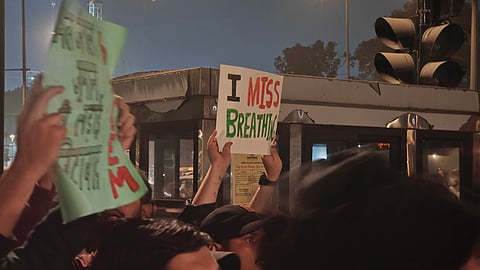I miss breathing: DTE employee recounts Delhi’s rare protest for the right to clean air
On November 9, 2025, Delhi’s AQI hit 391 — the worst of the season.
Over a hundred residents gathered at India Gate to demand urgent action on air pollution.
Police filed an FIR against “unknown persons” after detaining several protesters.
Down To Earth’s Ritika Bohra recounts what it was like to march for something as fundamental as clean air.
On November 9, 2025, Delhi witnessed a rare protest, one demanding something as fundamental as the right to breathe. As the city’s Air Quality Index (AQI) peaked at 391, the highest of the season at the time, more than a hundred residents from across the National Capital Region (NCR) gathered at India Gate, despite official warnings against public demonstrations.
The participants, from young children to the elderly, called for urgent government action on Delhi’s toxic air. Several protesters were detained and later released. On November 10, the Delhi Police filed an FIR against “unknown persons” for allegedly violating police orders and disturbing public order. By evening, some protesters claimed on social media that they had received notices to appear before a magistrate for violating the law.
The capital’s air showed a slight improvement on the morning of November 10 after touching a season’s high of 391 in the “very poor” category the previous day. By November 11, however, the situation worsened again, prompting authorities to invoke pollution curbs under “Stage 3” of the Graded Response Action Plan (GRAP) — restrictions on non-essential construction, older vehicles, and in-person classes for younger students.
Among those present at the protest was Ritika Bohra, Assistant Art Editor at Down To Earth. She was not detained but attended the protest to demand accountability and the right to breathe freely. Here’s her account of what transpired.
“AQI 1,000 ke paar, kahan gayi Rekha sarkaar!” (AQI crosses 1,000, where is Rekha’s government?) — the chants could be heard from afar as I rushed towards India Gate around 5 pm on November 10, 2025, where citizens had gathered to protest against Delhi’s suffocating air. Despite the government’s attempt to dissuade participation by publishing a notice denying permission to assemble at the venue, more than a hundred people turned up — all united by one demand: to reclaim our fundamental right to breathe clean air.
The protest drew college students, mothers with toddlers in their arms, and senior citizens. Some had walking sticks, others clutched inhalers. Many carried their doctor’s prescriptions detailing their respiratory issues and held up banners saying “I miss breathing”. While the majority of us seem to have given up on democracy, there were a handful of people trying to stand up to our indifferent government and the police, whose numbers exceeded those of the protesters.
The police presence was overwhelming. Using loudspeakers, officers warned people to disperse or move to Jantar Mantar, the officially designated protest site. But the chants only grew louder.
Within 45 minutes, the police started taking action, and aggressively began detaining the core group of protesters, dragging and pushing them towards waiting buses. In the chaos that followed, several parents trying to shield their children were also taken in. The scuffle saw elderly participants and even adolescents being caught up in the commotion. Yet, the crowd’s spirit didn’t falter. Another group of students soon stepped forward to take charge, holding their ground near the barricades even as police pushed them away from India Gate towards the other end of the road.
There was anger, disappointment, frustation and a deep sense of betrayal in the air. This was the feeling of Delhi’s citizens being failed by their own government. I met a few students pursuing science degrees and researchers who were at the forefront, shouting slogans but also explaining the underlying causes of the toxic air: Illegal factories operating unchecked within the city, emitting polluting fumes. Their outrage wasn’t just about the smog — it was about the sheer scale of corruption and the relentless pursuit of capitalist gain that have altogether sidelined public welfare and allowed this crisis to deepen.
If, as the authorities claim, the air has improved over the past decade, why are public funds worth lakhs being spent on air purifiers at the Chief Minister’s residence? Why does every third or fourth person in a family now suffer from respiratory allergies? Why do children grow up knowing what a nebuliser is from the moment they are born? These were the questions echoing through the crowd, which our government seems unwilling to confront, even as it fudges AQI data to maintain a facade of progress.
The protest came to an abrupt halt as a second wave of police dragged the remaining sloganeers into buses. The rest of the protestors like me, who had stood in silent support, took that as our cue to leave. But the messages — Hawa, paani sab barbaad! Iski jad mein punjiwaad! (Air and water, all ruined! Capitalism is at the root of it) — lingered long after the crowd had dispersed.
Let this not be the end — we need people to wake up, not give up, and continue the fight for our basic rights.

